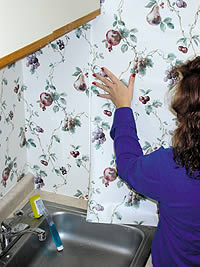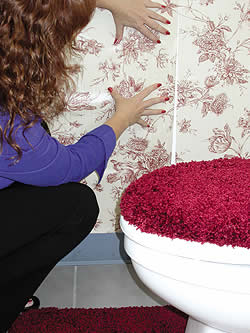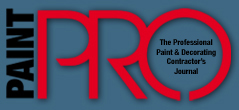
Wallpaper, Wallcovering Adhesives
The evolution of wallcovering adhesives through the years is making things a lot easier for wallpaper hangers, and new products formulated for specialty applications are being introduced all the time.
by Susan Brimo-Cox
adhesives through the years is making things a lot easier for wallpaper hangers, and new products formulated for specialty applications are being introduced all the time. Professionals now have the option to select products based on the specifics of individual projects and environmental conditions, such as humidity. Fortunately, wallcovering adhesives fall into several categories — powdered adhesives, clay adhesives, clear adhesives and specialty adhesives — which can help a paperhanger narrow the field of products he might choose from.

Wheat-based powdered products are where the wallcovering adhesive industry has its roots, reports Jerry Russo, president and CEO of Roman Decorating Products Inc. in Calumet City, Ill. But he says that while powdered adhesives are still available, use of them has greatly diminished. They are used more by retail customers than professionals, and primarily for specialty papers.
The biggest changes in the industry began in the mid 1950s, Russo says, when the industry transitioned into pre-mixed, liquid adhesives. The first were clay-based adhesives. Starch is still the base adhesive in these products, but clay as a filler gives them good wet tack — something that allowed paperhangers to hang vinyl wallcoverings.
Then, in the ‘60s, wallpaper adhesive technology improved again and clear adhesives were introduced. New modified starches used as the base adhesives provided good wet tack without the need for clay. Since the 1980s, a variety of specialty products have come on the market: vinyl-over-vinyl adhesives, border paper adhesive, prepasted activators, and primer-adhesive systems that guarantee against mold and mildew growth.
But powder adhesives may be making a comeback. Roos International has recently begun distributing Ecofix, a starch-based powder adhesive imported from Sweden. The Ecofix line is environmentally friendly, easy to use, and suitable to hang “almost anything,” says Deborah Roos, vice president of Roos International, adding that “sometimes the original ideas are the best.”
For most professionals, the choice between clay and clear adhesives is simply personal preference. Both products penetrate the backing of wallpaper, and when it dries, hold the wallcovering to the wall. At U.S. Vinyl Manufacturing Corp. in LaFayette, Ga., they describe it as the “mud puddle effect.” If you have a mud puddle and grass is added, when the puddle dries up you can’t pull the grass out. Clay and clear adhesives work in a similar physical way, and come in different weights for heavy and light wallcoverings.
It’s reported that clear is the predominant product that contractors use these days, but there are some good reasons to choose a clay adhesive for some applications.
John Blasko, sales manager with Gardner-Gibson in Tampa, Fla., points out that clay-based products “historically have been stronger.”
They also have a higher level of solids, so they are good for Lincrusta and other wallcoverings that have deep relief.
Clears are easy to clean up and result in less staining than clays, but some contractors like clay-based products because they can easily see if there’s any adhesive left on the wallcovering. “With clear adhesive, if there’s residual adhesive, it’ll collect dust, turn gray and you’ll get a call back,” Russo says.
Both clay and clear formulations are predominantly strippable, but there are occasions when a non-strippable adhesive is preferred. If you need a very strong bond — for example, for acoustical coverings — a non-strippable product may be called for.
Wet tack and open time vary from product to product, so be sure to read the product label to ensure you have the working time you need.
|

